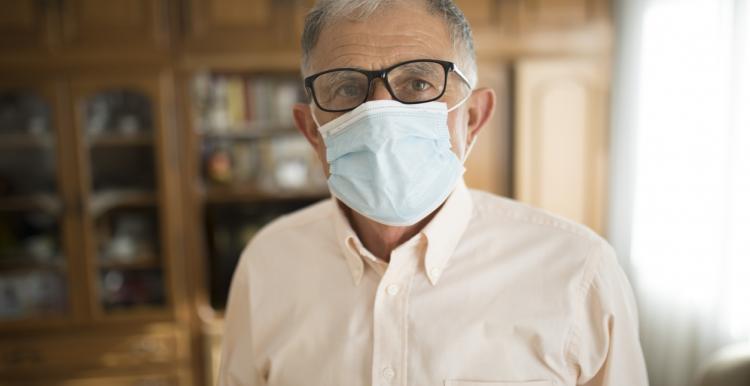What you need to know when visiting a care home (new guidance for COVID-19)

A rise in COVID-19 cases has led to the announcement of a national lockdown in England. Restrictions for the general public include reducing day-to-day contact with other people you do not live with.
Whilst the first priority in care homes remains to prevent infections and protect staff and residents, it is recognised how important it is to allow care home residents to safely meet their loved ones, especially for those at the end of their lives. That is why new guidance encourages care homes to provide safe visiting opportunities as new national restrictions come into effect.
Directors of public health (DPHs) and care providers should follow this guidance to ensure policies for visiting arrangements and decisions are based on a dynamic risk assessment and minimise risk wherever possible.
This guidance has been taken from gov.uk.
When will I be able to visit a care home?
From Thursday 5 November until Wednesday 2 December, all care home residents in England should be allowed to receive visits from their family and friends in a COVID-secure way.
All decisions on the circumstances, times and frequency of visits to care homes during lockdown will therefore be made by care home providers. These decisions should be reached through providers working with the resident, their family and friends, and other relevant professionals, such as social workers or clinicians where appropriate.
These decisions should also be made in line with advice from local directors of public health, who will be developing local ‘dynamic risk assessments’ based on the principles outlined in the government’s guidance.
Go to full guidance
For the most up to date guidance, including information of what should be included in your care home’s visiting policy, visit the Gov.uk website.
See also the guidance for supported living settings.
How do I find out the visiting policy of a care home?
Each home is unique, so providers will design their own visiting arrangements, taking into account the needs of their residents and what is possible within the layout and facilities within the home. In producing these policies, providers should work collaboratively with residents, families and local social care and health professionals to strike a good balance between the risks and benefits of visiting.
These visiting policies should be made available and/or communicated to residents and families, together with any necessary variations to arrangements due to external events.
Policies should include advice for residents and families and cover issues such as:
- visitors should be given support on how to prepare for a visit and given tips on how to communicate if face coverings are required, for example:
- speaking loudly and clearly
- keeping eye contact
- not wearing hats or anything else that might conceal their face further
- wearing clothing or their hair in a way that a resident would more likely recognise
- provide reassurance to visitors, including that some people with dementia might struggle at first to remember or recognise them. Care home staff should try and prepare the resident for a visit, perhaps by looking at photographs of the person who is due to visit and talking to them about their relationship
The frequency of visits are likely to be limited and/or controlled, and is down to the specific circumstances of the care home and those living and working within it.
It is recommended that the home has an arrangement to enable booking/appointments for visitors. If the home has previously operated an ‘open door’ visiting policy, then you should be informed of the change of arrangements and why this is necessary.
Can I arrange a visit for my loved one outside the care home setting?
Guidance for visits out of a care home, for example to a family home, is in development and will be provided shortly.
Do I need to take a test to be able to visit my relative?
No, however if you are displaying any symptoms of coronavirus you should not visit the care home, self-isolate and order a test immediately.
You may be asked screening questions upon arrival. These include:
- Have you been feeling unwell recently?
- Have you had recent onset of a new continuous cough?
- Do you have a high temperature? A care home may consider providing a temperature check for all visitors to provide confidence to visitors and to staff.
- Have you noticed a loss of, or change in, normal sense of taste or smell?
- Have you had recent contact (in the last 14 days) with anyone with COVID-19 symptoms or someone with confirmed COVID-19 – if yes, should you be self-isolating as a family member or as a contact advised to do so by NHS Test and Trace?
How do I travel to the care home?
It is encouraged that you walk or cycle to the home if you can.
It might be that some assistance is required to enable visitors who are especially vulnerable to get to the care home. Care homes may consider giving visitors telephone numbers or website information of organisations which can offer advice on safe travel arrangements if required.
What is likely to change when I visit my loved one?
You can expect to see a number of changes but remember they are to keep you and your loved ones safe. These include:
- Visits should take place outside, but given we are approaching winter, if this is not possible, appropriate visits include:
- Visits under a cover such as an awning, gazebo or open-sided marquee, where residents and visitors remain at least 2 metres apart.
- Visits in temporary outdoor structures, such as COVID-secure visiting areas/pods which are enclosed to some degree but are still outside the main building of the home. These areas can only allow one visiting party at a time, will require good ventilation and screens between residents and visitors.
- Visits in a dedicated room such as a conservatory, which can be accessed from outside of the home. These areas can only allow one visiting party at a time, will require good ventilation and screens between residents and visitors.
- Visits at a window.
- Visitors should enter visiting spaces from outside wherever possible. Where there is a single access point to the space, the resident and visitor must enter at different times to ensure safe distancing.
- Care workers will use Personal Protective Equipment (PPE) in line with guidance from Public Health England.
- In all cases, appropriate PPE must be used by visitors throughout the visit and around the care home building and grounds.
- Social distancing (between visitors and residents, staff, and visitors from other households) must be maintained at all times during the visit, and around the care home building and grounds.
- Care homes with an ‘open door’ policy may have to work towards a more regimented booking system. Ad hoc visits should not be allowed.
- Care homes should support NHS Test and Trace by keeping a temporary record (including address and phone number) of current and previous residents, staff and visitors, as well as keeping track of visitor numbers and staff.
- Visitors should have no contact with other residents and minimal contact with care home staff (less than 15 minutes / 2 metres). Where needed, conversations with staff can be arranged over the phone following an in-person visit
How many people can visit a care home at a time?
To limit risk, where visits do go ahead, this should be limited to a single constant visitor, per resident, wherever possible.
There should be an absolute maximum of 2 constant visitors per resident (taking into account individual residents’ circumstances).
This is in order to limit the overall numbers of visitors to the care home and the consequent risk of disease transmission.
Will I need to wash my hands or use hand sanitiser?
Yes, visitors should be reminded and provided facilities to wash their hands for 20 seconds or use hand sanitiser on entering and leaving the home, and to catch coughs and sneezes in tissues and clean their hands after disposal of the tissues.
What happens if I can’t see my family or friend in the care home?
If providers are unable to safely allow visits in line with new guidance, alternative ways of communicating between residents and their families and friends should be discussed and offered. The care home should also provide regular updates to residents’ loved ones on their mental and physical health, how they are coping and identify any additional ways they might be better supported, including any cultural or religious needs.
Visits to a COVID-19 positive resident should only be made in essential circumstances (for example, end of life).
What happens if there is an outbreak at the care home?
If there is a declared outbreak in a care home, then visiting will need to be restricted only to exceptional circumstances such as end of life. These restrictions will continue until the care home has been assessed to be in recovery. You should be informed of this.
